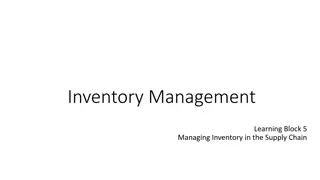Understanding the Bullwhip Effect in Supply Chains
The bullwhip effect is a phenomenon in supply chains where fluctuations in orders magnify as they move upstream. This distortion is caused by demand forecast updating, order batching, price fluctuations, and other factors. The result is increased uncertainty and inefficiency in the supply chain, impacting coordination and leading to distorted information and volatile demand patterns.
Download Presentation

Please find below an Image/Link to download the presentation.
The content on the website is provided AS IS for your information and personal use only. It may not be sold, licensed, or shared on other websites without obtaining consent from the author. Download presentation by click this link. If you encounter any issues during the download, it is possible that the publisher has removed the file from their server.
E N D
Presentation Transcript
Materi ke - 9 INFORMATION DISTORTION & BULLWHIP EFFECT Sumber : http://aeunike.lecture.ub.ac.id/files/2016/02/13-Distorsi-Informasi-dan-Bullwhip-effect.pdf
Bullwhip Effect The bullwhip effect is a well-known symptom of coordination problems in (traditional) supply chains It refers to the effect that the amount of periodical orders amplifies as one moves upstream in the supply chain towards the production end. The term was first coined around 1990 when Procter&Gamble perceived erratic and amplified order patters in its supply chain for baby diapers. The effect is also known by the names whiplash or whipsaw effect.
The Bullwhip Effect Distorted Information The amplification of uncertainty and order overstatement that cascades upstream through the nodes of the supply chain. The variance of orders is greater than that of sales, and the distortion increases as one moves upstream.
Bullwhip Effect Distorsi informasi merupakan salah satu kendala untuk menciptakan efisiensi pada supply supply chain BULLWHIP EFFECT Demand and sale pada peritel relatif stabil namun permintaan/aliran barang dari produsen ke suplier/distributor sering sangat fluktuatif Semakin ke hulu semakin fluktuatif
Bullwhip Effect Fluctuations in orders increase as they move up the supply chain from retailers to wholesalers to manufacturers to suppliers Distorts demand information within the supply chain Results from a loss of supply chain coordination
Penyebab Bullwhip Effect Demand Forecast Updating Order Batching Fluktuasi Harga Rationing and Shortage Gaming
Demand Forecast Updating Peramalan pada satu periode tertentu dan perlunya updating terus menerus, sehingga hasil peramalan yang lebih baik. Kebijakan reorder point atau order up-to level menyebabkan variabilitas order pesanan ritel lebih besar dibandingkan dengan permintaan pelanggan akhir. Model ramalan yang digunakan juga dapat berpengaruh terhadap intensitas bulwhip effect (Model ramalan yang kurang tepat).
Order Batching Ukuran pemesanan yang jumlahnya kecil sering tidak efisien dalam ongkos sehingga dilakukan pemesanan dalam jumlah besar dalam satu satuan waktu Produksi juga sering dilakukan sistem batch , jumlahnya besar dalam satu satuan waktu, serta pengirimannyapun jumlahnya besar dalam satu satuan waktu untuk menghindari ongkos yang tinggi Order mingguan atau 2 mingguan dari peritel lebih fluktuatif dibandingkan penjualan ke pelanggan akhir.
Fluktuasi Harga Adanya diskon menyebabkan perubahan permintaan seperti forward buying Produksi dapat saja kekurangan saat ada harga khusus pada pelanggan akhir Pada saat harga normal Stok diperitel banyak pemesanan ke ditributor dapat distorsi selama 2-3 bulan. Stok menumpuk Ongkos produksi meningkat
Rationing and Sortage Gaming Rationing Permintaan lebih tinggi dari persediaan Permintaan sering tidak terpenuhi 100% Peritel sering berusaha untuk meningkatkan permintaan Kasus seperti ini sering terjadi saat menjelang hari raya dan tahun baru(Tidak setiap saat) Pada saat persediaan cukup dari peritel maka pelanggan merubah pesanan atau membatalkannya.
Bullwhip Causes The bullwhip effect is mainly caused by three underlying problems: a lack of information the structure of the supply chain and a lack of collaboration.
Lack of Information No information except for the order amount is perpetuated up the supply chain. Without actual customer demand data, all forecasting has to rely solely on the incoming orders at each supply chain stage. In reality, in such a situation traditional forecasting methods and stock keeping strategies contribute to creating the bullwhip effect.
Supply chain structure The longer the lead time, i.e. the longer it takes for an order to travel upstream and the subsequent delivery to travel downstream, the more aggravated the bullwhip effect is likely to be. Hence, the longer the lead time is, the more pronounced an order will be as an reaction to an increase in forecasted demand (especially in conjunction with updating the safety stock levels, see above), which again contributes to the bullwhip effect.
Lack of Supply Chain Coordination and the Bullwhip Effect Supply chain coordination all stages of the chain take actions that are aligned and increase total supply chain surplus Requires that each stage share information and take into account the effects of its actions on the other stages Lack of coordination results when: Objectives of different stages conflict Information moving between stages is delayed or distorted
Causes of Bullwhip Effect Local information and decisions at each node Different forecast mechanisms at each node Information and communication lead time Production and distribution lead time Order padding Batch/opportunistic purchasing Unsynchronized ordering policies
Impact of Bullwhip High inventory/lost sales/backlog cost Low operational efficiency underutilization overtime Poorcustomer service levels Unnecessary capacity investment Swings in working capital Blaming others; frustration, helplessness
How to Counteract the Bullwhip Effect 1. Avoid Multiple Demand Forecast Updates 2. Break Order Batches 3. Stabilize Prices 4. Eliminate Gaming in Shortage Situations
Avoid Multiple Demand Forecast Updates Bullwhip effects are created when supply chain members process the demand input from their immediate downstream member in producing their own forecasts. Demand input from the immediate downstream member, of course, results from that member s forecasting, with input from its own downstream member. One remedy to the repetitive processing of consumption data in a supply chain is to make demand data at a downstream site available to the upstream site. Hence, both sites can update their forecasts with the same raw data.
Avoid Multiple Demand Forecast Updates In the computer industry, manufacturers request sell- through data on withdrawn stocks from their resellers central warehouse. Although the data are not as complete as point-of-sale (POS) data from the resellers stores, they offer significantly more information than was available when manufacturers didn t know what happened after they shipped their products. IBM, HP, and Apple all require sell- through data as part of their contract with resellers. Supply chain partners can use electronic data interchange (EDI) to share data.
Break Order Batches One reason that order batches are large or order frequencies low is the relatively high cost of placing an order and replenishing it. EDI can reduce the cost of the paperwork in generating an order. Using EDI, companies such as Nabisco perform paperless, computer assisted ordering (CAO), and, consequently, customers order more frequently. Another reason for large order batches is the cost of transportation. The differences in the costs of full truckloads and less-than-truckloads are so great that companies find it economical to order full truckloads, even though this leads to infrequent replenishments from the supplier.
Break Order Batches The use of third-party logistics companies also helps make small batch replenishments economical. These companies allow economies of scale that were not feasible in a single supplier-customer relationship. By consolidating loads from multiple suppliers located near each other, a company can realize full truckload economies without the batches coming from the same supplier.
Stabilize Prices The simplest way to control the bullwhip effect caused by forward buying and diversions is to reduce both the frequency and the level of wholesale price discounting. The manufacturer can reduce the incentives for retail forward buying by establishing a uniform wholesale pricing policy.
Eliminate Gaming in Shortage Situations Gaming during shortages peaks when customers have little information on the manufacturers supply situation. The sharing of capacity and inventory information helps to alleviate customers anxiety and, consequently, lessen their need to engage in gaming. But sharing capacity information is insufficient when there is a genuine shortage. Some manufacturers work with customers to place orders well in advance of the sales season. Thus they can adjust production capacity or scheduling with better knowledge of product demand. The generous return policies that manufacturers offer retailers aggravate gaming. Without a penalty, retailers will continue to exaggerate their needs and cancel orders. Not surprisingly, some computer manufacturers are beginning to enforce more stringent cancellation policies.























